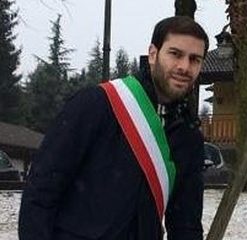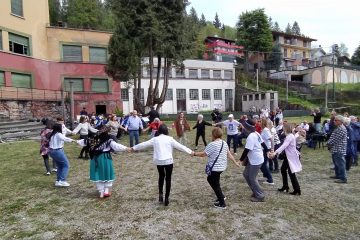By courtesy of the author and the publisher, we are posting an essay by Valeria Dani dedicated to the recovery of Sciesopoli’s memory: The Fascist Colony of Sciesopoli: Transformation and Abandonment:
>> READ EBOOK OF THE COMPLETE TEST BY VALERIA DANI >>
The essay is part of the book: “DP camp IT 82: Cremona. Arrival and Departure Trajectories, Crossings, Lives, History”, Proceedings of the Cremona Round Table, 28 January 2017, curated by Roberta Aglio and Monica Feraboli, Cremona, Fantigrafica, 2017.
To purchase the printed version, contact:
Biblioteca del Seminario Vescovile, via Milano 5, 26100 Cremona
Tel. 0372458289 – Email: biblio.seminario@gmail.com
<<…
The question I asked myself, and that I ask of you, is this: beyond an aestheticization, which certainly is not at the center of my intervention, to what extent does an ontological discourse on ruins concern the Sciesopoli building?
The most consistent help for a possible answer comes from the twentieth-century philosopher who, as a constant, has occupied my academic career for years: Walter Benjamin. A German Jew of extraordinary theoretical density, persecuted by the Nazis and dying a suicide in an attempt to escape them, Benjamin places at the center of many of his philosophical reflections the ambiguity of the ruined object in a dimension, I believe, perfectly similar to the story of the building of Sciesopoli in our present.
We can recall that both in his Arcades Project (written between 1927 and 1940) and in the fundamental “Theses on the Philosophy of History” (1940), ruins embody the ambivalence and darkness of the modern. According to the philosopher, we must redeem the horrors of history and its tortured ruins:
“it is not a task that is assumed and guaranteed by the divinity or by the history of humanity (almost as if these horrors had been necessary for an improvement or the landing of some collective bliss) […]. In Walter Benjamin, the only possible redemption is that offered by memory: only by preserving the memory of the victims, and therefore testifying to their departure, the senselessness of their defeat and their suffering, can we interrupt the winners’ mythical time, or the vision of the Official story that still remains to the hypothetical and incontrovertible “fact” excluding the scope of “possibilities not given.” For this, the essential fulcrum of his theses is the reversal of the traditional relationship between past and present: if we usually have always conceived of the present as the resultant of a flow of events that comes from the past, Benjamin conceives the past as the other side of the present and, arising from and produced by it, it is the present that generates its past from within, and the past cannot exist independently of a present that bears witness to it and redeems it (Cfr. Alfieri, Alessandro. The Angelus Novus: the redeeming angel of Walter Benjamin. Messianic time and dialectical image, April 17, 2012, <http://www.fucinemute.it/2012/04/langelus-novus-langelo-redentore-di-walter-benjamin>
[visited 12/01/2018]).
 It is therefore necessary to turn our attention to objects that official history considers not worthy of our attention, in order to free them from marginalization, to redeem them and reveal their ethical and political value. Walter Benjamin writes in his sixth thesis on the philosophy of history:
It is therefore necessary to turn our attention to objects that official history considers not worthy of our attention, in order to free them from marginalization, to redeem them and reveal their ethical and political value. Walter Benjamin writes in his sixth thesis on the philosophy of history:
“To articulate the past historically does not mean to recognize it “the way it really was” (Ranke). It means to seize hold of a memory as it flashes up at a moment of danger. Historical materialism wishes to retain that image of the past which unexpectedly appears to man singled out by history at a moment of danger. The danger affects both the content of the tradition and its receivers. The same threat hangs over both: that of becoming a tool of the ruling classes. In every era the attempt must be made anew to wrest tradition away from a conformism that is about to overpower it. […]
Only that historian will have the gift of fanning the spark of hope in the past who is firmly convinced that even the dead will not be safe from the enemy if he wins. And this enemy has not ceased to be victorious.” (Cfr. Benjamin, Walter. These on the Philosophy of History, New York 1968, pp. 255).
 In many ways, today, we find ourselves living in what Walter Benjamin calls the moment of danger. It adopts multiple forms: from the specter of neo-fascism woven into the populism in Europe and the United States, to the threat of an ever-dead anti-Semitism. But let us also reflect and this is especially true with respect to the Sciesopoli building, threatened by the conformist and annihilating nature of neoliberal, capitalist oblivion, which attempts to annul the old (considered obsolete) and its historical memory by relegating it to neglect and silence.>> (See Valeria Dani, “The Fascist Colony of Sciesopoli: Transformation and Abandonment”, pp. 43-44).
In many ways, today, we find ourselves living in what Walter Benjamin calls the moment of danger. It adopts multiple forms: from the specter of neo-fascism woven into the populism in Europe and the United States, to the threat of an ever-dead anti-Semitism. But let us also reflect and this is especially true with respect to the Sciesopoli building, threatened by the conformist and annihilating nature of neoliberal, capitalist oblivion, which attempts to annul the old (considered obsolete) and its historical memory by relegating it to neglect and silence.>> (See Valeria Dani, “The Fascist Colony of Sciesopoli: Transformation and Abandonment”, pp. 43-44).




